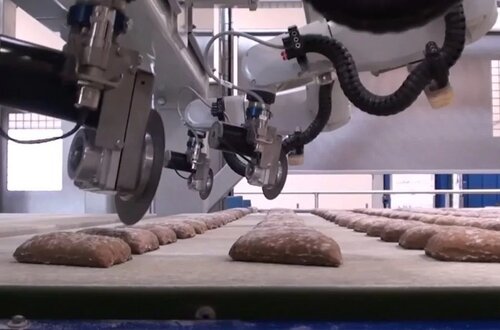Baking Machine for Biscuits
In the Baking Machine for Biscuits, soft wheat flour is the major ingredient. Wheat flour has a carbohydrate content of 65 to 75 percent and a protein content of 7 to 16 percent. When water is introduced during dough preparation, starch absorbs a large amount of water and may function as a filler in the continuous protein network.
In the food production business, the baking industry is the most stable. Wheat flour is the primary ingredient in the majority of the goods in this line. Cookies, crackers, cakes, pastries, and biscuits are all made with the addition of water and numerous additional components. Biscuits are baked goods that are flat and crisp, whereas cookies are softer and thicker.
Cracker biscuits are low-sugar, low-fat biscuits that are often bland or flavorful. These flour confections are tasty, convenient to transport, and don't require any additional preparation before eating, therefore they're regarded as basic snacks.
The gelatinization of starch granules, which is a main component of the dough, occurs during baking. Normally, flour for cookies and crackers is not treated with additives. For cookies to be premium grade, soft wheat flour comprising 8 to 10 percent protein and less than 0.4 percent ash content is perfectly suited. The textural qualities of baked goods are influenced by water.
In a baking machine for biscuits, water works as a plasticizer, and the amount of water used is controlled to generate a batter or dough with a suitable consistency for processing. Water is required to hydrate proteins, gelatinize the starch, activate enzymes, dissolve sugar and salt, and act as a significant heat transmission mechanism during baking via evaporation and condensation.
Fat gives items a short character, such as a soft, pleasant, and crumbly texture. in the baking machine for biscuits Fats and oils are utilised in dough and batters, as well as in surface sprays, cream fillings, and chocolate coatings. Emulsifiers are frequently premixed with or used in combination with bakery fats.
In a baking machine for biscuits soft wheat goods like biscuits, cookies, and cakes, sugar is the most significant component after flour. Sweeteners provide one or more of the following tasks in addition to giving sweetness to the product: tenderising, texture, yeast nutrition and fermentation control, stabilising, bulking agent, humectant, flavour, crust colour, and shelf-life extension.
In the production of soft wheat goods, sucrose, corn syrup solids, inverted sugar, honey, glucose syrup, and some approved strong sweeteners are utilised. Salt is used to season or enhance the flavour of the dough. Salt also suppresses yeast development, which aids with fermentation control. Leavening agents, emulsifiers, chocolates, egg products, dairy products, fat replacers, spices, flavours, colours, frosting, and other ingredients are used in the manufacturing of biscuits in a baking machine for biscuits.
Baking powder is commonly used to leaven the dough for cookies and biscuits. It helps to regulate the spread and gives the product a lighter feel. Excessive sodium bicarbonate (baking soda) usage may result in an alkaline flavour in the finished product.
Ammonium bicarbonate should only be used in items that are completely dry after baking; otherwise, if the product is damp, the ammonium odour will be maintained. Baking soda is a salt made up of sodium bicarbonate and an acid. When moisture is present during baking, gas is produced, which aids in the leavening of the result.
Process of Baking machine for biscuits
The dough mixer is used to combine materials including flour, sugar, oil, water, and other chemicals to make firm, soft, or fermented dough in a baking machine for biscuits.
A base plate on which two side frames are mounted to support the load of the bread dough mixer's mixing chamber, which is mounted on side frames. Two Z/sigma-type mixing blades are installed in the mixing chamber of the bread dough mixer, which rotates at different speeds in opposing directions to mix various types of soft/hard dough to get the needed amount of dough. To discharge combined dough, an electrically driven tilting mechanism is also included in the mixing chamber. To reduce dust and dangers, the machine is completely enclosed on all sides.
Soft dough and soft cookies are made with a rotary moulder in the baking machine for biscuits. The dough to be moulded is placed in the hopper, where it is forced into the cavities of the moulding roller, which is constructed of gunmetal, evenly etched, and coated with food-grade Teflon. To guarantee equal filling, the excess dough is cleaned using a knife kept in place by a tool steel holder.
The discharge cotton web is pressed consistently against the moulding roller by an adjustable rubber roller, ensuring precise transfer of moulded items from the moulding roller to the web. The objective of the three drives is to change the density of dough pressed into the moulding cavity by changing the speed of the forcing roller. The manufacturing speed is influenced by the speed of the die roller. The form of the biscuits generated along the web or across the web is influenced by the web speed of discharge.
The single-head rotary cutter chops out individual dough pieces while printing precise designs on a constantly fed dough sheet. It's used to make Marie, thin arrowroot, blackjack, petit-beer, Monaco, and other salty biscuits before baking. A 1.5KW helical geared motor drives the device, which is controlled by an AC frequency controller. Only the cutting roller receives power to suit various die sizes in this machine.
The height of the rubber-lined anvil roller may be adjusted so that pressure can be managed in parallel or separately on both sides. The anvil roll is propelled by the cutting web's friction, which is propelled by its distinct motor. The cutting roll has protection for safety reasons, and removing it stops the engine.
The body of the baking machine for biscuits is made up of a steel steam-tight tube with evenly separated radiator zones. To prevent the oven portion from expanding, stainless steel expansion joints are placed between these zones.
During the baking process, the inspection doors are used to check the baked items. To preserve heat and boost efficiency, the whole chamber of the baking machine for biscuits will be insulated with a miner that will fill from the outside. The chamber will be supplied with a completely automatic imported burner, and the temperature will be regulated by an automatic temperature controller on the control panel.
The top, bottom, and sides of the entire baking machine for the biscuit oven will be insulated with 10" thick mineral wool insulation. CRC sheets will be used to cover the bottom half of the oven on the sidewalls to protect the conveyor and prevent heat loss. Radiators located under and above the wire mesh band transfer heat evenly for consistent baking in the heating chamber of the biscuit baking oven. These radiators' recirculating heating gases may be adjusted independently for each zone.
A little vacuum exists in the closed recirculation system, preventing combustion gases from entering the baking chamber. The ventilation fan circulates the heating gases via the recirculation system, and the burners are thermostatically regulated. The cooling conveyor is made up of 2.5-meter-long modules that are connected to form the required length. The side channels for support are made of a 3mm thick M.S. sheet.
On the conveying route, idle rollers are 750mm apart, and on the return direction, they are 1700mm apart. All idle rollers are 48mm in diameter and are mounted on 6004 ZZ deep groove ball bearings with a grinding finish and hard chrome plating for hygienic purposes. Before being transported to the cooling conveyor, the Oil Spray Machine is used to spray fine most edible oil over the top and bottom of hot biscuits coming out of the oven.
Our principal
Kaak Group, in association with Kiron Food Processing Technologies, provides a comprehensive baking biscuits solution. The Kaak Group bridges the gap between traditional bread-making and cutting-edge industrial bakery technologies. The Kaak Group assists you in your business with a comprehensive variety of goods and services as well as a unique whole-service philosophy.







